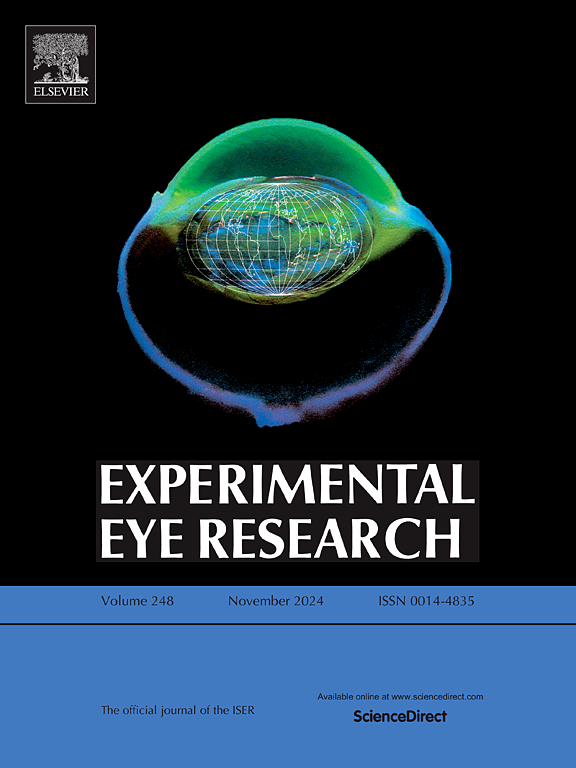Cultivation and characterization of oral mucosal epithelial cells on fibrin gel in a xenobiotic-free medium for the treatment of limbal stem cell deficiency
IF 3
2区 医学
Q1 OPHTHALMOLOGY
引用次数: 0
Abstract
For the treatment of bilateral limbal stem cell deficiency (LSCD), cell therapy with transplantation of cultivated oral mucosa epithelial cells (COMET) is a promising alternative. Although not yet established, current protocols on the cultivation of oral mucosal epithelial cell (OMECs) sheets are based mainly on substrates and xenobiotic additives that may lead to variable outcomes and undesirable immune responses by the patient. The aim of this study was to characterize OMECs cultivated in xenobiotic-free media (XF) seeded on fibrin gel, in comparison to conventional complex (COM) medium. Oral mucosal biopsies were retrieved from 31 donors. After cultivation in COM or XF medium, OMECs were compared based on growth kinetics, morphology, cell size and viability. Using immunofluorescence and gene expression analyses, the degree of stemness, proliferation and differentiation was evaluated in OMEC cultures. Our findings showed that although OMECs showed a similar morphology and viability, and comparable growth kinetics, immunofluorescence revealed the preservation of stemness (p63 + p40 positivity in cells ≤11 μm) and proliferation in both COM and XF. Gene expression analyses showed that keratin (K)13 and K15 expression levels were significantly higher in XF (adj. p < 0.001), but otherwise COM and XF-treated OMECs had comparable transcriptional profiles in a panel of stemness, proliferation and differentiation genes. These results demonstrate the feasibility of culturing OMECs on fibrin gel without xenogeneic additives, while maintaining their undifferentiated state and preserving stemness. In conclusion, both in terms of results and methodology, the procedures presented here are suitable for implementation in clinical practice.

在无外源药物的培养基中,纤维蛋白凝胶培养口腔黏膜上皮细胞并对其特性进行表征,用于治疗角膜缘干细胞缺乏症。
对于双侧角膜缘干细胞缺乏症(LSCD)的治疗,移植培养的口腔黏膜上皮细胞(COMET)是一种很有前景的治疗方法。虽然尚未建立,但目前口腔粘膜上皮细胞(OMECs)片的培养方案主要基于底物和外源添加剂,这可能导致患者的不同结果和不良免疫反应。本研究的目的是表征在纤维蛋白凝胶上无异种抗生素培养基(XF)中培养的OMECs,并与传统复合物(COM)培养基进行比较。对31名供者进行口腔黏膜活检。在COM或XF培养基中培养后,比较OMECs的生长动力学、形态、细胞大小和活力。利用免疫荧光和基因表达分析,评估了OMEC培养物的干性、增殖和分化程度。我们的研究结果表明,尽管OMECs表现出相似的形态和活力,以及相似的生长动力学,但免疫荧光显示在COM和XF中都保持了干性(≤11 μm细胞中p63+p40阳性)和增殖。基因表达分析显示,角蛋白(K)13和K15的表达水平在XF中显著升高(p < 0.001),但COM和XF处理的omec在一组干细胞、增殖和分化基因中具有相似的转录谱。这些结果表明,在不添加异种添加剂的纤维蛋白凝胶上培养omec的可行性,同时保持其未分化状态并保持其干性。总之,在结果和方法方面,这里提出的程序适合在临床实践中实施。
本文章由计算机程序翻译,如有差异,请以英文原文为准。
求助全文
约1分钟内获得全文
求助全文
来源期刊

Experimental eye research
医学-眼科学
CiteScore
6.80
自引率
5.90%
发文量
323
审稿时长
66 days
期刊介绍:
The primary goal of Experimental Eye Research is to publish original research papers on all aspects of experimental biology of the eye and ocular tissues that seek to define the mechanisms of normal function and/or disease. Studies of ocular tissues that encompass the disciplines of cell biology, developmental biology, genetics, molecular biology, physiology, biochemistry, biophysics, immunology or microbiology are most welcomed. Manuscripts that are purely clinical or in a surgical area of ophthalmology are not appropriate for submission to Experimental Eye Research and if received will be returned without review.
 求助内容:
求助内容: 应助结果提醒方式:
应助结果提醒方式:


